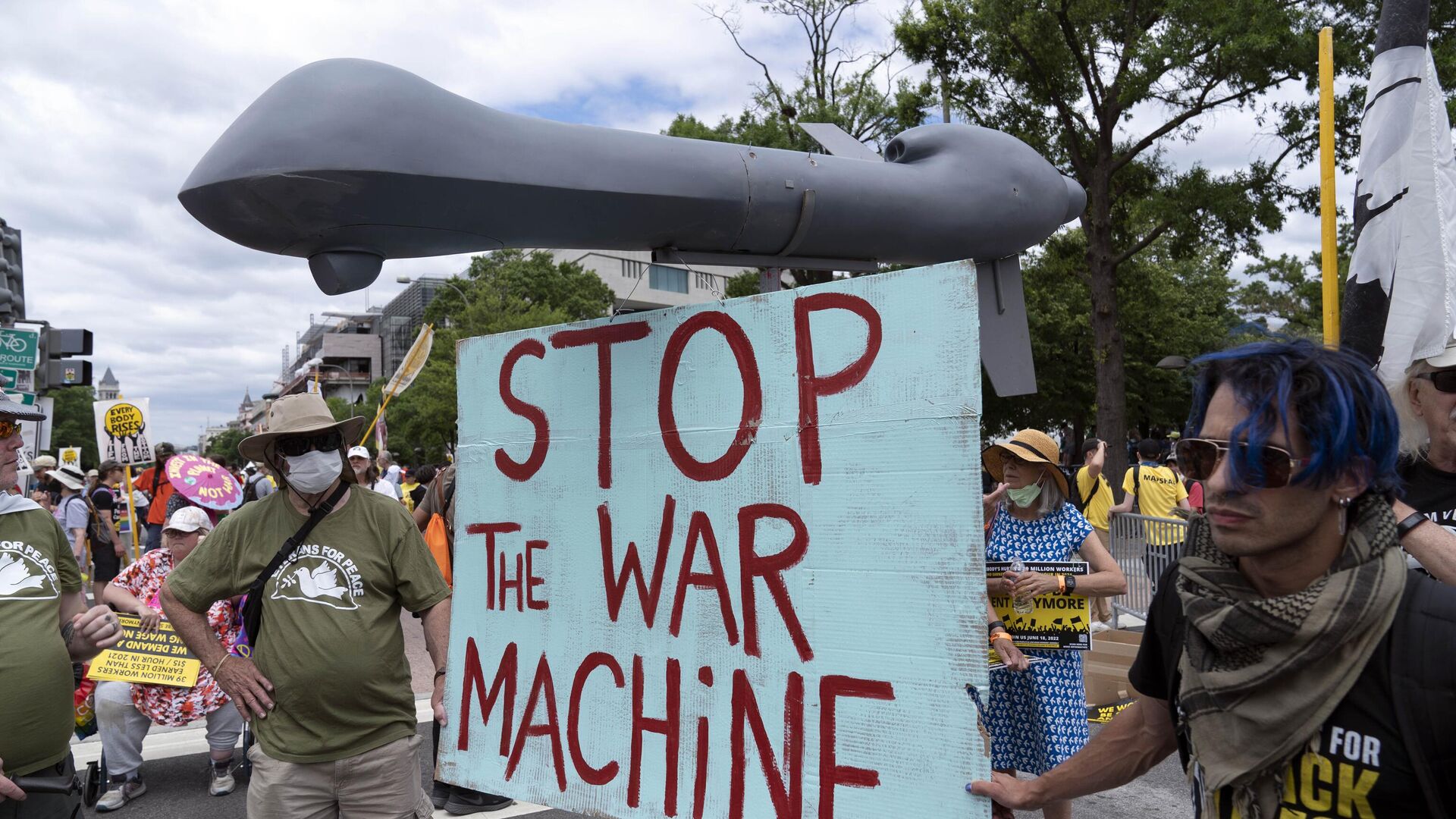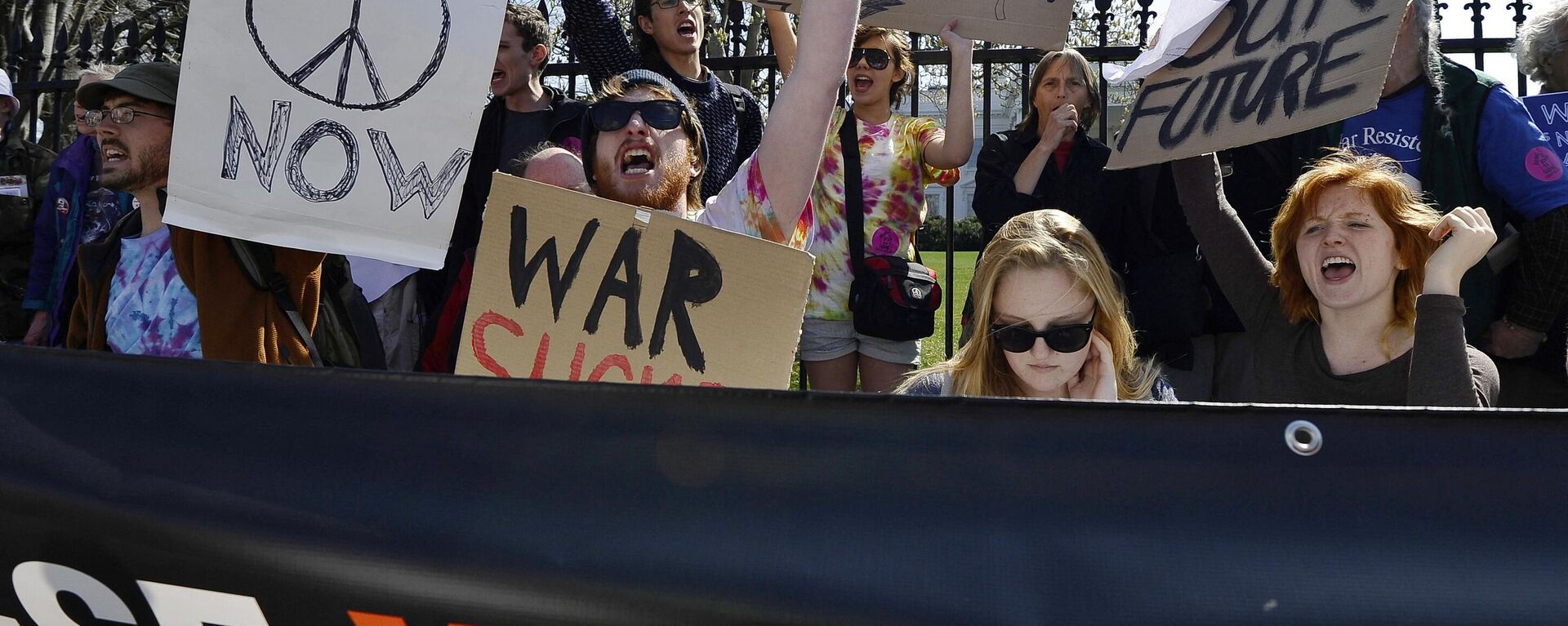https://sputnikglobe.com/20230320/the-rise-and-fall-of-the-us-anti-war-movement-1108560954.html
The Rise and Fall of the US Anti-War Movement
The Rise and Fall of the US Anti-War Movement
Sputnik International
The US invasion of Iraq was marked by mass protests around the world, with the biggest rallies of 15 and 16 February of 2003 being attended by six to ten million people worldwide.
2023-03-20T06:00+0000
2023-03-20T06:00+0000
2023-03-20T06:00+0000
20 years since us invasion of iraq
iraq
iraq war
2003 invasion of iraq
us
mass media
https://cdn1.img.sputnikglobe.com/img/07e7/03/13/1108561494_0:160:3073:1888_1920x0_80_0_0_558b19bea9e653201d278e9a23ba567a.jpg
One month later, a US-led coalition launched a massive invasion of the Middle Eastern nation, toppling Saddam Hussein’s government and bringing chaos to Iraq.Sputnik sat down with two prominent American anti-war activists to discuss the rise and the eventual decline of the US grassroots peace movement during the Iraq War.Michael Žmolek teaches world history, international studies, and development studies at the University of Iowa. In the early 2000s he was among those actively opposing the bombing, sanctions and military occupation of Iraq. Žmolek was one of the organizers of the February 15, 2003 protest in New York. He recalls that it was “a big crowd, close to a quarter million” in the Big Apple. The city was apparently unprepared for the rally, with many questions still arising about the actions of the police:Most demonstrators were angered by the official reason for the invasion. According to Žmolek, from the very beginning activists knew that the rationale behind the US-led invasion of Iraq – namely Saddam’s alleged possession of chemical weapons, was completely made up, with the Bush administration “pulling various tales out of its hat” to justify the war:Political writer and activist Sara Flounders has been involved in the peace movement since the 1960s. She is currently serving as co-director of the International Action Center (IAC) – a group that supports anti-imperialist movements around the world. Flounders traveled to Iraq herself before the war, and has a similar view on the reasons for the 2003 US invasion:Besides New York, the peace rallies of February 15, 2003 were held in London, Berlin, Rome, Paris, Moscow, and hundreds of other places. The Guinness Book of Records listed the march in the Italian capital with its three million participants as the biggest anti-war rally in human history.In the following years, protesters – most of them representing grassroots organizations, even received support from Hollywood celebrities such as Sean Penn, Jane Fonda, and Danny Glover.Despite the emerging power of the peace movement, major media corporations sought to belittle and marginalize its activists.Both Žmolek and Flounders said that many mainstream outlets have been bringing grist to Pentagon’s mill, giving much less airtime to peace activists and mostly voicing talking points of the Bush administration:Sara Flounders, in turn, has called some journalists’ behavior “a paid-for media prostitution,” saying that they were purposely choosing “pro-war” angles.Even though the peace activists were at first successful in winning people’s hearts and minds, the situation started changing for the worse over the years, leading to the eventual overall decline of the anti-war efforts.Michael Žmolek says that at times, the movement’s diversity has played against it:Sara Flounders has pointed out that many activists were intimidated by the negative media coverage, growing tired of being treated “as a non-person,” with the cruelty of the war itself contributing to eventual mass disappointment:The chaos brought by the American invasion worsened the sectarian conflict in Iraq and led to the eventual rise of Daesh* in the region.The casualties of the conflict were immense, with Iraqi civilian death count estimates varying from 275,000 to 306,000. As per Watson Institute data, 4,598 members of the US military, 3,650 US contractors, as well as 282 international media representatives, and 63 NGO workers lost their lives in Iraq during the period between March 2003 and August 2021.The majority of US troops were withdrawn from the war-torn nation by the end of 2011, although around 2,500 are still stationed in the country to this day. In the years and months preceding the withdrawal, there was a sharp decrease in the number of demonstrators rallying in American and European cities. Around 100 peace activists were arrested outside the White House on March 19, 2011, with other streets in the American capital being virtually “protester-free.”*Daesh, or ISIS/ISIL, is a terrorist organization banned in Russia and many other countries.
https://sputnikglobe.com/20230318/us-needs-new-anti-war-movement-to-see-through-hypocrisy--lies-of-media-justifying-invasions-1108537020.html
https://sputnikglobe.com/20230308/us-lawmakers-applaud-senate-panel-for-passing-bill-to-end-gulf-iraq-war-authorizations-1108192179.html
iraq
Sputnik International
feedback@sputniknews.com
+74956456601
MIA „Rossiya Segodnya“
2023
Denis Bolotsky
https://cdn1.img.sputnikglobe.com/img/07e5/06/0b/1083128270_0:0:961:960_100x100_80_0_0_8cd81dafcbaac1c176c25141f8af1d2a.jpg
Denis Bolotsky
https://cdn1.img.sputnikglobe.com/img/07e5/06/0b/1083128270_0:0:961:960_100x100_80_0_0_8cd81dafcbaac1c176c25141f8af1d2a.jpg
News
en_EN
Sputnik International
feedback@sputniknews.com
+74956456601
MIA „Rossiya Segodnya“
Sputnik International
feedback@sputniknews.com
+74956456601
MIA „Rossiya Segodnya“
Denis Bolotsky
https://cdn1.img.sputnikglobe.com/img/07e5/06/0b/1083128270_0:0:961:960_100x100_80_0_0_8cd81dafcbaac1c176c25141f8af1d2a.jpg
us invasion of iraq, mass protests, biggest rallies, anti-war movement
us invasion of iraq, mass protests, biggest rallies, anti-war movement
The Rise and Fall of the US Anti-War Movement
The US invasion of Iraq was marked by mass protests around the world, with the biggest rallies of February 15 and 16 2003 being attended by six to ten million people worldwide. The outcry, however, did not break the Pentagon’s war plans.
One month later, a US-led coalition launched a massive invasion of the Middle Eastern nation, toppling Saddam Hussein’s government and bringing chaos to Iraq.
Sputnik sat down with two prominent American anti-war activists to discuss the rise and the eventual decline of the US grassroots peace movement during the Iraq War.
Michael Žmolek teaches world history, international studies, and development studies at the University of Iowa. In the early 2000s he was among those actively opposing the bombing, sanctions and military occupation of Iraq. Žmolek was one of the organizers of the February 15, 2003 protest in New York. He recalls that it was “a big crowd, close to a quarter million” in the Big Apple. The city was apparently unprepared for the rally, with many questions still arising about the actions of the police:
“In New York the police had penned in the protesters and this is an issue that came up recently. There was a big lawsuit recently with one of the big protests where the protesters were awarded damages because of the way in which they were pent up,” Žmolek told Sputnik.
Most demonstrators were angered by the official reason for the invasion. According to Žmolek, from the very beginning activists knew that the rationale behind the US-led invasion of Iraq – namely Saddam’s alleged possession of chemical weapons, was completely made up, with the Bush administration “pulling various tales out of its hat” to
justify the war:
“We were quite clear that it was a fabrication. I think we're a little bit surprised that it happened at all, just given how brazen it was and how the evidence had been prepared as if it were based on fact.”
Political writer and activist Sara Flounders has been involved in the peace movement since the 1960s. She is currently serving as co-director of the International Action Center (IAC) – a group that supports anti-imperialist movements around the world. Flounders traveled to Iraq herself before the war, and has a similar view on the reasons for the 2003 US invasion:
“Iraq had been so thoroughly disarmed, it was beyond a fabrication,” Sara Flounders told Sputnik. “I was in Iraq with a delegation of Ramsey Clark and other anti-war activists. Three weeks before Shock and Awe. And at that time, everyone knew in Iraq that this war was coming. There was nothing they could do to stop it.”
Besides New York, the peace rallies of February 15, 2003 were held in London, Berlin, Rome, Paris, Moscow, and hundreds of other places. The Guinness Book of Records listed the march in the Italian capital with its three million participants as the biggest anti-war rally in human history.
In the following years, protesters – most of them representing grassroots organizations, even received support from Hollywood celebrities such as Sean Penn, Jane Fonda, and Danny Glover.
Despite the emerging power of the peace movement, major media corporations sought to belittle and marginalize its activists.
Both Žmolek and Flounders said that many mainstream outlets have been bringing grist to Pentagon’s mill, giving much less airtime to peace activists and mostly voicing talking points of the Bush administration:
“We were very frustrated with the way in which the media would constantly roll out one retired general after another, one Pentagon expert after another that was espousing a pro-war point of view.” – said Michael Žmolek.
Sara Flounders, in turn, has called some journalists’ behavior “a paid-for media prostitution,” saying that they were purposely choosing “pro-war” angles.
“The US mainstream media is absolutely an accomplice of US wars. They operate hand in hand with the military. They're embedded in the military. They're given their story lines on a daily basis during a war,” she added.
Even though the peace activists were at first successful in winning people’s hearts and minds, the situation started changing for the worse over the years, leading to the eventual overall decline of the anti-war efforts.
Michael Žmolek says that at times, the movement’s diversity has played against it:
“It's hard to get a strong, consistent, pro-peace anti-war position when you've got a lot of groups that, say, are working with one or the other parties, or are much larger than most of the other groups. Nobody's really clear what their agenda is, and yet they're organizing the rallies. A lot of people show up for rallies with no idea who the organizers were. It's a bit like herding cats.”
Sara Flounders has pointed out that many activists were intimidated by the negative media coverage, growing tired of being treated “as a non-person,” with the cruelty of the war itself contributing to eventual mass disappointment:
“I think the sheer horror of shock and awe absolutely demoralized millions of people and then the war was simply declared over, but the occupation was just beginning.“
The chaos brought by the American invasion worsened the sectarian
conflict in Iraq and led to the eventual rise of Daesh* in the region.
The casualties of the conflict were immense, with Iraqi civilian death count
estimates varying from 275,000 to 306,000. As per Watson Institute
data, 4,598 members of the US military, 3,650 US contractors, as well as 282 international media representatives, and 63 NGO workers lost their lives in Iraq during the period between March 2003 and August 2021.
The majority of US troops were withdrawn from the war-torn nation by the end of 2011, although around 2,500 are still stationed in the country to this day. In the years and months preceding the withdrawal, there was a sharp decrease in the number of demonstrators rallying in American and European cities. Around 100 peace activists were arrested outside the White House on March 19, 2011, with other streets in the American capital being virtually “
protester-free.”
*Daesh, or ISIS/ISIL, is a terrorist organization banned in Russia and many other countries.





